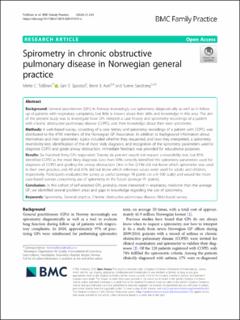| dc.contributor.author | Tollånes, Mette Christophersen | |
| dc.contributor.author | Sjaastad, Geir E. | |
| dc.contributor.author | Aarli, Bernt Bøgvald | |
| dc.contributor.author | Sandberg, Sverre | |
| dc.date.accessioned | 2021-08-04T12:09:47Z | |
| dc.date.available | 2021-08-04T12:09:47Z | |
| dc.date.created | 2020-11-29T13:24:23Z | |
| dc.date.issued | 2020 | |
| dc.identifier.issn | 1471-2296 | |
| dc.identifier.uri | https://hdl.handle.net/11250/2766223 | |
| dc.description.abstract | Background
General practitioners (GPs) in Norway increasingly use spirometry diagnostically as well as in follow up of patients with respiratory complaints, but little is known about their skills and knowledge in this area. The aim of the present study was to investigate how GPs interpret a case history and spirometry recordings of a patient with chronic obstructive pulmonary disease (COPD), and their knowledge about their own spirometer.
Methods
A web-based survey, consisting of a case history and spirometry recordings of a patient with COPD, was distributed to the 4700 members of the Norwegian GP Association. In addition to background information about themselves and their spirometer, topics included whether they requested, and how they interpreted, a spirometry reversibility-test, identification of the of most likely diagnosis, and recognition of the spirometry parameters used to diagnose COPD and grade airway obstruction. Immediate feedback was provided for educational purposes.
Results
Six hundred thirty GPs responded. Twenty six percent would not request a reversibility test, but 81% identified COPD as the most likely diagnosis. Less than 50% correctly identified the spirometry parameters used for diagnosis of COPD and grading the airway obstruction. One in five (21%) did not know which spirometer was used in their own practice, and 49 and 61% did not know which reference values were used for adults and children, respectively. Participants evaluated the survey as useful (average 74 points on a 0–100 scale) and would like more case-based surveys concerning use of spirometry in the future (average 91 points).
Conclusion
In this cohort of self-selected GPs, probably more interested in respiratory medicine than the average GP, we identified several problem areas and gaps in knowledge regarding the use of spirometry. | en_US |
| dc.language.iso | eng | en_US |
| dc.publisher | BMC | en_US |
| dc.rights | Navngivelse 4.0 Internasjonal | * |
| dc.rights.uri | http://creativecommons.org/licenses/by/4.0/deed.no | * |
| dc.title | Spirometry in chronic obstructive pulmonary disease in Norwegian general practice | en_US |
| dc.type | Journal article | en_US |
| dc.type | Peer reviewed | en_US |
| dc.description.version | publishedVersion | en_US |
| dc.rights.holder | Copyright The Author(s). 2020 | en_US |
| dc.source.articlenumber | 235 | en_US |
| cristin.ispublished | true | |
| cristin.fulltext | original | |
| cristin.qualitycode | 1 | |
| dc.identifier.doi | 10.1186/s12875-020-01310-x | |
| dc.identifier.cristin | 1853760 | |
| dc.source.journal | BMC Family Practice | en_US |
| dc.identifier.citation | BMC Family Practice. 2020, 21, 235. | en_US |
| dc.source.volume | 21 | en_US |

